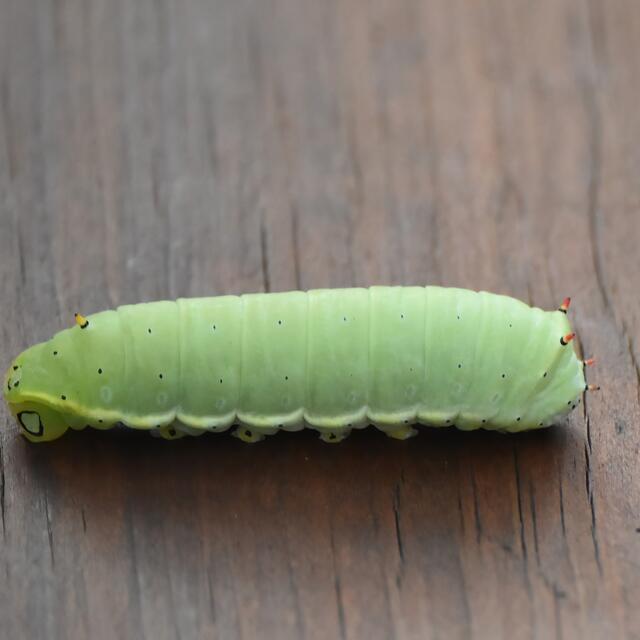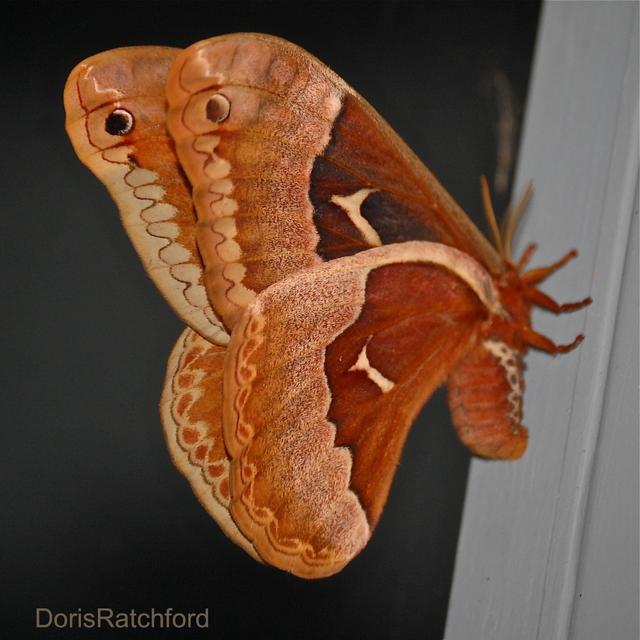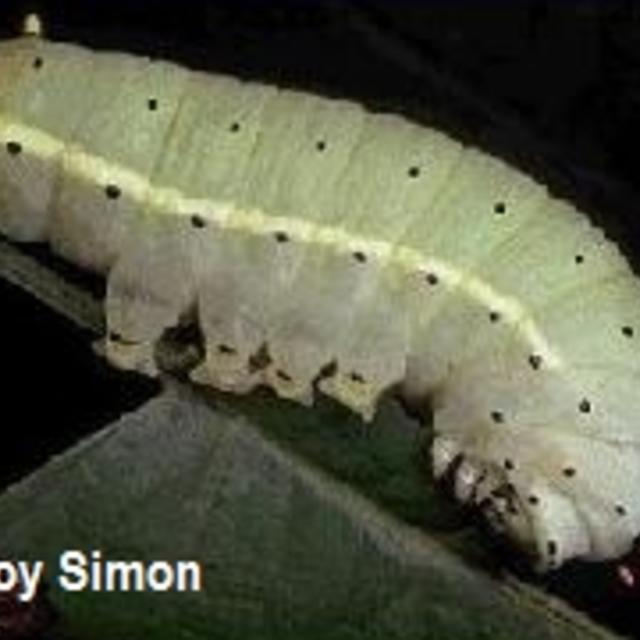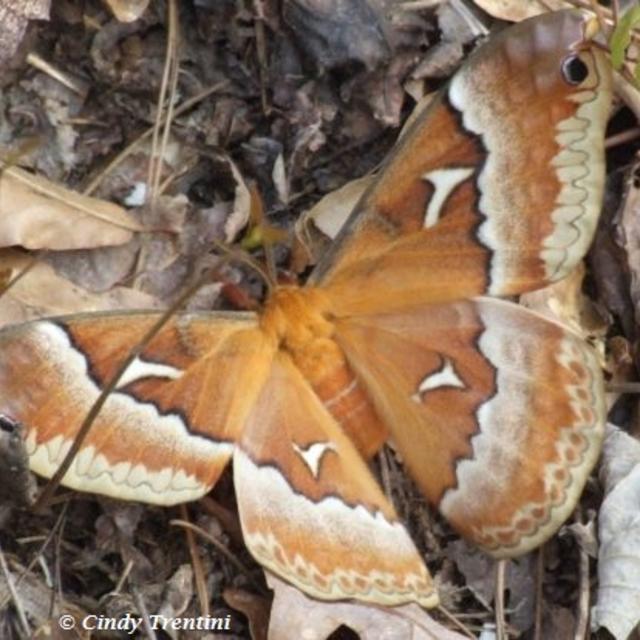Tuliptree silkmoth
Callosamia angulifera (Walker, 1855)
Family: Saturniidae
Subfamily: Saturniinae
Identification: Males and females differ. Male upperside is brown with angular white cell spots on all wings and much contrast between the basal and outer portions of the wings. Underside has a very light pink band to the outside of the postmedian line. Female upperside is yellowish brown; angular white cell spots are largest on the forewings. Underside of hindwing has mahogany red at its darkest part. Both sexes of the summer brood are darker.
Wing Span: 3 1/8 - 4 5/16 inches (8 - 11 cm).
Life History: Mating occurs between dusk and midnight, with most activity around 10 PM. Females lay eggs at dusk the following evening, in rows of 4-10 on tulip trees. Eggs hatch in one week and the young caterpillars feed in groups. Older caterpillars are solitary and do not eat the main vein of the leaf. Dark brown cocoons are spun in a curled leaf which falls to the ground.
Flight: One brood from June-August in the north, two broods from March-April and in August in the south.
Caterpillar Hosts: Yellow poplar (Liriodendron tulipifera) in the magnolia family.
Adult Food: Adults do not feed.
Habitat: Deciduous woodlands.
Range: Massachusetts east through central New York, southern Ontario, and southern Michigan to central Illinois; south to the Florida panhandle and Mississippi.
Conservation: Not usually required.
NCGR: G5 - Demonstrably secure globally, though it may be quite rare in parts of its range, especially at the periphery.
Management Needs: None reported.
Comments: NULL
Please donate!
We depend on donations to keep Butterflies and Moths of North America freely available. We want to express our gratitude to all who showed their support by making a contribution this year. You can donate to support this project at any time.
Advertise with us!
Do you have a product or service that you think would interest BAMONA users? If you would like to advertise on this website, contact us by email, or use the contact form and select the "Advertising" category.
Verified Sightings
Displaying 1 - 24 of 570 verified sightings

Observation date: Aug 18, 2025
Submitted by: Victoria Molnar
Region: Goochland County, Virginia, United States
Verified by: rogerdowner
Verified date: Aug 18, 2025

Observation date: Aug 09, 2025
Submitted by: Colleen K
Region: Robertson County, Tennessee, United States
Verified by: rogerdowner
Verified date: Aug 10, 2025

Observation date: Jul 27, 2025
Submitted by: pauhana
Region: Davidson County, Tennessee, United States
Verified by: rogerdowner
Verified date: Aug 01, 2025

Observation date: Apr 17, 2025
Submitted by: CEBS
Region: Cherokee County, Georgia, United States
Verified by: Mikelchap
Verified date: Jul 20, 2025

Observation date: Apr 29, 2025
Submitted by: snakeowl
Region: Fulton County, Georgia, United States
Verified by: Mikelchap
Verified date: Jul 20, 2025

Observation date: Jul 06, 2025
Submitted by: JoAnn-Alegre
Region: New Castle County, Delaware, United States
Verified by: rogerdowner
Verified date: Jul 06, 2025

Observation date: Apr 30, 2025
Submitted by: scottj4hops
Region: Jessamine County, Kentucky, United States
Verified by: rogerdowner
Verified date: May 03, 2025

Observation date: Jun 28, 2023
Submitted by: Dave Webb
Region: Maryland, United States
Verified by: rogerdowner
Verified date: Apr 01, 2025

Observation date: Jul 15, 2023
Submitted by: gjkoppel
Region: Highland County, Ohio, United States
Verified by: rogerdowner
Verified date: Oct 07, 2024

Observation date: Jul 14, 2023
Submitted by: gjkoppel
Region: Highland County, Ohio, United States
Verified by: rogerdowner
Verified date: Sep 22, 2024

Observation date: Jun 25, 2024
Submitted by: Jeffrey Ney
Region: Berks County, Pennsylvania, United States
Verified by: curtis.lehman
Verified date: Aug 27, 2024

Observation date: Aug 02, 2024
Submitted by: RidgetownRick
Region: Ontario, Canada
Verified by: curtis.lehman
Verified date: Aug 06, 2024

Observation date: Jun 27, 2024
Submitted by: Nelson Mostow
Region: Cuyahoga County, Ohio, United States
Verified by: rogerdowner
Verified date: Jun 29, 2024

Observation date: Jun 05, 2024
Submitted by: Linda Marie Finn
Region: Johnson County, Tennessee, United States
Verified by: rogerdowner
Verified date: Jun 13, 2024

Observation date: Jun 08, 2024
Submitted by: TheRefuge
Region: Madison County, Virginia, United States
Verified by: rogerdowner
Verified date: Jun 13, 2024

Observation date: Jun 12, 2024
Submitted by: Punkin8or
Region: Anne Arundel County, Maryland, United States
Verified by: rogerdowner
Verified date: Jun 13, 2024

Observation date: May 03, 2024
Submitted by: Lady4datruth
Region: Pickens County, Georgia, United States
Verified by: Mikelchap
Verified date: Jun 09, 2024

Observation date: May 19, 2024
Submitted by: Flipper1970
Region: Swain County, North Carolina, United States
Verified by: rogerdowner
Verified date: May 25, 2024

Observation date: Mar 16, 2024
Submitted by: WilKat
Region: Beaufort County, South Carolina, United States
Verified by: Dennis Forsythe
Verified date: Mar 18, 2024

Observation date: Oct 13, 2023
Submitted by: Chip Gilbert
Region: Greenville County, South Carolina, United States
Verified by: John Calhoun
Verified date: Oct 18, 2023

Observation date: Aug 06, 2023
Submitted by: MayaBee73
Region: Johnson County, Tennessee, United States
Verified by: rogerdowner
Verified date: Sep 13, 2023

Observation date: Jul 01, 2023
Submitted by: Jlongmire
Region: Kemper County, Mississippi, United States
Verified by: stomlins701
Verified date: Aug 10, 2023

Observation date: Aug 13, 2010
Submitted by: Susan McSwain
Region: Nelson County, Virginia, United States
Verified by: rogerdowner
Verified date: Aug 05, 2023

Observation date: Jul 12, 2023
Submitted by: butterfly_girly
Region: Chester County, Pennsylvania, United States
Verified by: curtis.lehman
Verified date: Jul 26, 2023
- 1 of 24
- next ›

















